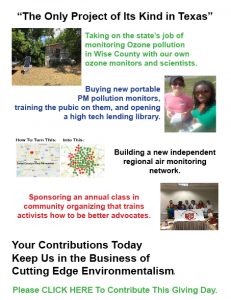Archive for September 2018
Vote for Us and Ours
CLICK HERE TO VOTE FOR THE GREENSOURCE AWARDS 
Downwinder board member Evelyn Mayo for Coke Buchanan Volunteer of the Year
DFW Air Research Consortium for Environmental Science and Innovation
GoodWork Co-Working Space for Environmental Science and Innovation
The GreenSource DFW Leadership Awards are one of the only ways, and certainly the most popular way, the DFW environmental community recognizes accomplishments among its own ranks. They’re now in their seventh year and the end-of-the-year awards dinner where the winners are announced is the rare Big Tent event on the local green calendar.
There’s a nomination process, followed by a selection committee within Green Source staff, and then they open up the list of final nominees to a popular vote of sorts. We’re in the voting period now. And in this election, you can vote every 24 hours during the two-week voting period, ending September 30th. So you really can vote early and often…legally.
There are awards for green-writing journalists, green groups and green people, er activists. This year we’re lucky to have direct ties to three nominees and we hope you do vote for them often over the next three days.
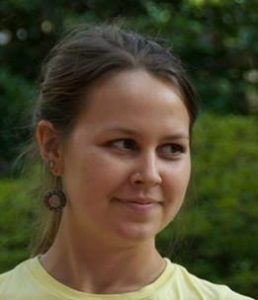 Downwinders board member Eveyln Mayo is nominated for the Coke Buchanan Volunteer of the Year Award. This award goes to a person showing outstanding volunteer service to a green cause or organization.
Downwinders board member Eveyln Mayo is nominated for the Coke Buchanan Volunteer of the Year Award. This award goes to a person showing outstanding volunteer service to a green cause or organization.
We’ll let the text accompanying her GreenSource nomination speak for itself:
“At 23, Evelyn Mayo may be one of the youngest environmental organizers in DFW, but she has the bearing of a veteran eco-warrior. Arriving in DFW fresh out of college only 14 months ago, she joined the board of Downwinders at Risk and has helped revitalize that group by leading it into new areas of program work and attracting a team of inspiring 20 and 30-something women to join her.
Evelyn has been the Chair of Downwinders’ Particulate Matter Campaign Committee since its creation last Fall. In that role, she’s helped raise the profile of a long-ignored pollutant.
She initiated and helped host community meetings on the dangers of PM. She’s a liaison between Downwinders and the North Texas Transit Riders to help better protect a population that’s routinely exposed to high levels of PM pollution.
She coordinated the deployment of Downwinders’ portable PM monitors in the Joppa neighborhood that revealed high levels of PM there when City staff was trying to reassure residents with the readings of an EPA monitor nine miles away.
Now she’s helping to assemble a “Justice for Joppa” support committee that can assist the neighborhood in addressing a long list of grievance and needed reforms. And if that weren’t enough, she’s also helping direct Downwinders’ “Green Streets” bus electrification campaign.
It was the portable air monitoring Evelyn coordinated on behalf of the Joppa community that sealed the fate of the two batch plants seeking permits to set-up shop there. Anyone attending the City Council meting in March when the plant permits were debated heard constant references to the dangers of PM – even by batch plant lobbyists themselves. That was Evelyn’s work. That citizen monitoring project has also given new impetus to the city of Dallas joining a regional air quality monitoring network, which would be about the most important local air quality development in a long while.
Evelyn has become a reliable bridge between communities of color and the local environmental scene. Not just in Joppa, but throughout DFW. She’s looked upon by both residents and activists as a hardworking honest broker for their concerns. In this capacity she’s been responsible for re-focusing Downwinders as an Environmental Justice advocacy group, and re-setting the environmental agenda in Dallas as a whole.”
And that’s why we want you to vote for Evy.
Downwinders and its partners in the DFW Air Research Consortium are nominated for the Environmental Science and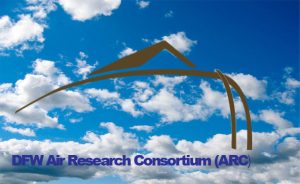 Innovation Award for building the North Texas Clean Air Network – the first local, independent regional air monitoring network in the state.
Innovation Award for building the North Texas Clean Air Network – the first local, independent regional air monitoring network in the state.
In nominating DFW ARC, GreenSource listed the advantages of having such a network in place: “There are the impacts one can think of now and the ones we can’t imagine on this end of things. In the short term, monitors along a facility’s fence line might act like 24/7 environmental beat cops and discourage polluters from even thinking about shady discharges “at night, weekends and holidays” that would have been routine before. Plano proposed to use the network to help time traffic lights and find the pattern that most reduced vehicle pollution along major streets. The public and officials could track pollution levels in real time during accidents and fires, providing better evacuation routes and warnings. You can track work productivity, school absenteeism, ER asthma visits, heart attacks and strokes with pollution levels and then estimate how much economic cost there really is to “bad air days.” Neighborhoods can map their own air pollution burdens, showing that they’re already breathing higher levels of pollution than other parts of town.”
The organization of ARC itself is a model for collaboration among scientists, citizen groups, and local officials to harness technology for the public health. It’s been a very effective organization in a relatively short amount of time.
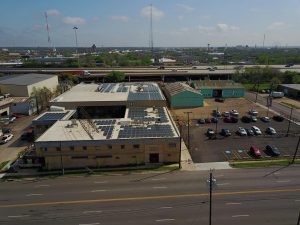
Finally, Downwinders new home, the GoodWork Coworking Space south of Downtown Dallas has also been nominated for the Environmental Science and Innovation Award. GoodWork is the first coworking space in the nation focused on inclusive sustainability and wellness for entrepreneurs, non-profits and innovators, powered by the largest concentration of solar panels in Central Dallas (provided by Downwinders’ Sue Pope Fund). D Magazine called it the “superfood of coworking.”
What’s been really interesting to watch since we moved here in February is how many South Dallas entrepreneurs, non-profits and freelancers have found a home where they feel comfortable, forming networks and communities that weren’t available to them before because nothing like GoodWork was around to provide it. Many of them are grassroots disruptors of the status quo in their own areas of expertise just as Downwindes tries to be in air quality and social justice. You won’t meet your typical co-worker type and that suits us fine because we’re not your typical environmental group.
We wish all the nominees luck, but these three maybe more so. See you at the awards dinner.
First Citizen Scientists Graduate From Portable Air Monitoring Training Class

L to R: Amanda Poland, Misti O’Quinn, Dr. Tate Barrett, James Orenstein, Temeckia Derrough, Candice Johnson, Evy Mayo, Jim Duncan, Kim Limberg, Liz Alexander, Miriam Mathews Fields and Cresanda Allen
In the middle of the wettest day in the wettest September DFW had ever recorded, the clouds parted and a dozen brave and curious souls turned out to go through the region’s first citizen science training for portable air monitoring.
Some were already clean air activists. Some were technology geeks. Some were people simply interested in having the ability to tell what’s in the air they’re breathing.
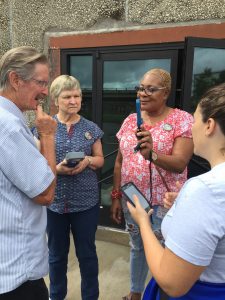 When they showed up to our GoodWork headquarters they got a tag team education on Particulate Matter pollution courtesy of a curriculum designed and presented by Downwinders board members and scientists. The information set-off lively discussions among residents of Joppa and West Dallas where PM problems are common. For others, the facts brought new awareness about this under-publicized but insidious pollutant.
When they showed up to our GoodWork headquarters they got a tag team education on Particulate Matter pollution courtesy of a curriculum designed and presented by Downwinders board members and scientists. The information set-off lively discussions among residents of Joppa and West Dallas where PM problems are common. For others, the facts brought new awareness about this under-publicized but insidious pollutant.
But no doubt many thought the real fun started with the hands-on field training using Downwinders’ three Aeroqual 500 Portable PM monitors. Despite the forecast, there was actually no rain during either the morning or afternoon session and the future scientists got to go explore inside and out.
They recorded the dust explosion set off by simply sweeping the floor with a broom. They saw how a lit match changed the composition of the air in a room. They stood downwind from fog machines that were faux-smokestacks for the day and they measured the ambient air in Sunny South Dallas on Good-Latimer. They learned how to sync meteorological tools with the monitors and record the necessary information to make a sampling more useful. They asked questions, they got in arguments and at the end of it all, they got certified as an official Citizen Science Apprentices. They’ll now be able to go out with our PM team for supervised research runs and after two of those they’ll be able to check out monitors on their own through our monitor lending library.
Our PM Committee is already looking to host another training session on a weekend in late October and these will be reoccurring on a regular basis from here on out. Be the first one on your block.
The Long March To Environmental Justice Begins with First “Let Joppa Breathe Alliance” Meeting
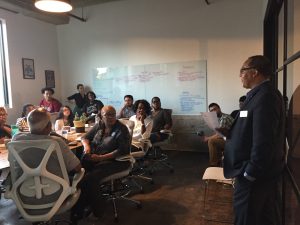
Council Member Kevin Felder welcomes participants to the Let Joppa Breathe meeting at GoodWork last Monday night.
Approximately 20 representatives from advocacy groups, non-profits, and neighborhoods gathered last Monday evening at GoodWork for the very first meeting of the “Let Joppa Breathe Alliance.” It was the first step in organizing a city wide effort to reverse over a century of racist zoning and land use planning in Dallas’ oldest Freedman’s community.
Besides Downwinders, there were members of Joppa Freeman’s Township Assocition, the South Central Civic League, the Inclusive Communities Project, Paul Quinn College, the NAACP, North West Texas Legal Aid, and Mia Carmen Theater company. As impressive as the breadth of support was, it was also the first time in memory that whites constituted a tiny fraction of attendance at a citywide Dallas environmental strategy meeting.
Rage Almighty, the spoken word artist who MC’d the May 22nd Joppa benefit was back to facilitate. District 7 Council  Member Kevin Felder was also back to welcome participants and encourage the building of the broadest possible coalition to win victories.
Member Kevin Felder was also back to welcome participants and encourage the building of the broadest possible coalition to win victories.
On the agenda were updates from the community, including photographic evidence presented by JFTA’s Temeckia Derrough of continued dust and diesel pollution problems from the existing Martin Marietta batch plant operation. There are continuing rumors about the company coming back to request a second chance at permitting the two proposed batch plants that were denied by the city council in March.
There was also discussion about how the group can estimate the emissions from all the short-haul diesel locomotives going back and forth in the Union Pacific switch yard that runs the length of the entire community. Usually the engines that end up in a switch yard are already old and in need of maintenance – yard duty is seen a step away from retiring the locomotive. Their exhaust contains a very toxic form of PM called Carbon Black that’s more carcinogenic than your average PM pollution. Electrification of these locomotives would eliminate a significant source of PM pollution in Joppa.
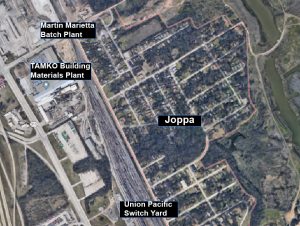 Misti O’Quinn with Downwinders reported that the group and UTD were very close to reaching a deal to place the first air monitor in Joppa, with a location to be announced soon. Another ten have been ordered and will probably be ready to be installed by November. The search is on for locations, with emphasis on getting front line readings close to batch plant, switch yard and the TAMKO shingles plant.
Misti O’Quinn with Downwinders reported that the group and UTD were very close to reaching a deal to place the first air monitor in Joppa, with a location to be announced soon. Another ten have been ordered and will probably be ready to be installed by November. The search is on for locations, with emphasis on getting front line readings close to batch plant, switch yard and the TAMKO shingles plant.
Plans are in the works to have a neighborhood enforcement workshop that includes the staff from City of Dallas Office of Environmental Quality, North West Texas Legal Aid attorneys and others advising residents how to be more effective in making complaints that can stick and lead to changes. Tentative scheduling has it penciled in for a date in later October or early November.
Participants scheduled the next Let Joppa Breathe Alliance meeting for 6 to 8 pm on Tuesday, October 23rd at GoodWork Co-Working space, 1808 S. Good Latimer. All groups are invited to send a representative. This isn’t just an environmental issue. It’s a civil rights issue. The more groups we represent, the faster we can get needed change.
The North Texas Clean Air Network Gets an Unanimous Vote in its First Dallas City Hall Test…But Staff is Still Resisting
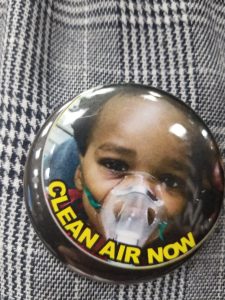 Rebuking its own staff’s misinformation campaign, the Dallas City Council’s seven-member Quality of Life Committee voted unanimously at its Monday morning meeting to recommend joining the North Texas Clean Air Network.
Rebuking its own staff’s misinformation campaign, the Dallas City Council’s seven-member Quality of Life Committee voted unanimously at its Monday morning meeting to recommend joining the North Texas Clean Air Network.
But in an unusual move, staff requested and received an almost three-month delay in scheduling a full city council vote on endorsing the new local air monitoring system. It won’t be until December 5th when the entire council gets briefed on the Network, and December 12th when they actually vote on whether to join. That’s a very long gestation period for a measure that just passed in Committee 7-0.
Staff claimed they wanted the long pause because of what they said were questions about how the city would participate in the Network and what provisions were necessary to get access to monitor locations like….utility poles. Citizens might be forgiven for suspecting the real reason for the three-month delay is to give staff time to find some new “fatal flaw” in the network and scuttle the whole thing before it ever comes up for a vote. If one listened hard enough, you could hear the startled disbelief in staff’s comments when the yes vote came down, despite every outward sign pointing to that outcome.
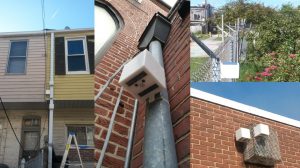 When one considers there was a Dallas city staffer at just about every meeting that led up to the creation of the Network, that these meetings began over a year ago, and that this specific presentation and vote has been scheduled for the Council’s review since August, it’s really quite incredible that staff admits they’ve spent no time thinking about how to implement this proposed policy within the city limits. Maybe because they’ve spent so much time trying to shoot it down.
When one considers there was a Dallas city staffer at just about every meeting that led up to the creation of the Network, that these meetings began over a year ago, and that this specific presentation and vote has been scheduled for the Council’s review since August, it’s really quite incredible that staff admits they’ve spent no time thinking about how to implement this proposed policy within the city limits. Maybe because they’ve spent so much time trying to shoot it down.
As late as the Friday before Monday’s vote staff was still at it, sending out a memo to Committee members downplaying the need for any regional network, conveying regulatory-correct but scientifically-misleading language about local Particulate Matter pollution levels, and writing one of the oddest sentences we’ve ever seen associated with air quality monitoring. In dismissing the formidable capabilities of the kind of low-cost high tech sensors the Clean Air Network will be using, Dallas Assistant City Manager Joey Zapata concluded, “These low-cost air sensors present new opportunities for uses beyond regulatory monitoring but are not yet able to provide direct measurements of real-time health impacts.“
That’s because that’s not what air pollution sensors or monitors do. None of them. Nada. Zero. Not even the really big and expensive ones the City currently operates for the State and EPA. They can only measure what levels of PM pollution are in the air you’re breathing, not what cancers, birth defects, strokes, heart attacks, diabetes problems, IQ loss, dementia or other illnesses that PM Pollution are causing “in real time” in your body as you breathe it in. No such Star-Trek-like technology exists.
In the real world researchers take the PM measurements recorded by sensors and correlate them to rates of illness. It’s a branch of science called epidemiology. The staff memo manages to completely confuse two wildly different scientific methods in a stunning, head-shaking way. It’d be flat-earth funny if it wasn’t, you know, the official position of Dallas City staff on the subject. Then it just becomes embarrassing.
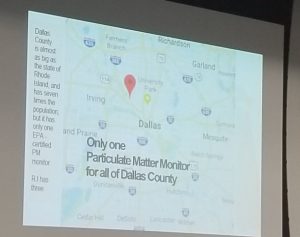 But whatever doubts about the Network staff tried to infect the council members with, they seemed to vanish once UTD Physics Professor Dr. David Lary and Downwinders’ Jim Schermbeck, representing the DFW Air Research Consortium, gave their 35-minute presentation on the Network.
But whatever doubts about the Network staff tried to infect the council members with, they seemed to vanish once UTD Physics Professor Dr. David Lary and Downwinders’ Jim Schermbeck, representing the DFW Air Research Consortium, gave their 35-minute presentation on the Network.
A roomful of “Clean Air Now” button-wearing supporters also helped the cause considerably. Thanks to everyone who came on an early Monday morning to make sure the Committee did the right thing. Thanks also to everyone who sent in emails to the Committee via our prepared Citizen Action website feature.
That combination of grassroots support plus technical expertise is one of the things that’s so impressive about this bottom-up approach, and it paid off again in the Committee meeting. Schermbeck made the case for change, Lary gave the details of how to build that change, monitor by monitor.
D Magazine published an online piece Monday morning that provides a point-by-point rationale for why this Network is A Big Idea Whose Time Has Come. Basically Big, Expensive and Slow has been replaced with Small, Cheap and Fast and it’s democratizing air quality information. All of that was included in the Committee presentation, plus examples of how it could have made a difference in the real world during a past crisis like the Sunshine Recycling Fire of December last year in West Dallas.
Both Plano and Dallas County officials have already said they’re onboard with the Network and may act to ratify the founding documents in their jurisdiction before the scheduled December Dallas vote. By the end of the year a new 21st Century regional air monitoring system, driven by local expertise, controlled by local governments, and designed to promote public health could become a reality.
But citizens may still have to fight to see it happen. In an ironic twist, the same staff that has been opposing the idea of Dallas joining the Network is now in charge of writing the briefing paper for the Council to explain why it’s a good idea. Bets are already being taken on how well they succeed.
ARC’s Network presentation was only half of an interesting compare and contrast exercise looking at two local projects using air sensors in two very different ways that Chair Sandy Greyson had arranged for the Committee.
The other half was a presentation by the Texas Nature Conservancy outlining their city staff-supported “resiliency” (i.e. Rockefeller) project, the “Breathe Easy” study proposing to place a PM and ozone monitor for two years at nine DISD schools that already see high student asthma and absenteeism rates, all below Interstate 30. Breathe Easy has already started spending money and needed no vote…although it was the first time any Council Committee had been briefed on it.
The study was supposed to get started back in August with the beginning of the school year but the nine schools haven’t been announced yet and so no monitors have been installed. Since the 2018-19 academic year is designed to provide a “baseline” of student asthma health, the study has already missed its chance of getting any data during the worst summer for ozone pollution in five years. It could take another month or longer to name the schools and wire-up the monitors. It’s uncertain how much this gap of missing information diminishes the value or definition of a baseline to which three specific intervention efforts are to be measured against beginning in the 2019-20 academic year.
Those intervention efforts include vehicle idling policies at or near schools, screens of vegetation between the 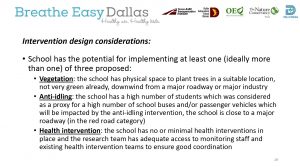 street and school, and in-school asthma therapies. The question being posed by the study is whether these intervention efforts have any impact on school-site pollution levels and therefore student asthma or absenteeism rates that can be measured.
street and school, and in-school asthma therapies. The question being posed by the study is whether these intervention efforts have any impact on school-site pollution levels and therefore student asthma or absenteeism rates that can be measured.
There’s certainly no harm in doing this study, but… its about ten years behind the times and spends a lot of money to tell us what we already know.
For example, we know DFW children’s asthma levels are higher than the national average. In their presentation, the TNC uses the 2009 Cook’s Children’s Hospital study made infamous by Downwinders almost a decade ago. That study contains the map showing a huge diagonal swath of childhood asthma running the length of Tarrant County that almost exactly syncs-up with the prevailing pollution plumes from the three Midlothian cement plants. Downwinders used that map time and again to prove the impact of the cement plants on downwind health during our Green Cement Campaign.
We know asthma is worse in minority communities. Many green groups were speaking out about this fact during the first wave of Environmental Justice activism during the 1990’s and have never stopped. What’s interesting is that TNC and the staff never ever talk about WHY this is a fact. It’s like they consider it an inherent genetic defect.
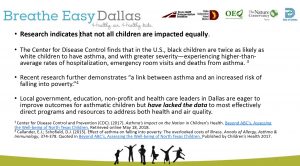 One reason might be that the Dallas City Hall staff now feigning concern for sick black kids is the same crew responsible for actively pressing racist zoning and land use planning in black and brown neighborhoods, like their predecessors before them.
One reason might be that the Dallas City Hall staff now feigning concern for sick black kids is the same crew responsible for actively pressing racist zoning and land use planning in black and brown neighborhoods, like their predecessors before them.
It was only last March when they were recommending approval for those two new batch plants in Joppa. Only last February when they recommended the Ash Grove Cement Silo in West Dallas. Before that they approved the move of the Argos batch plant from trendy Trinity Groves to a location next to a school in West Dallas.
Why do black kids have higher asthma rates in Dallas? Perhaps because the City of Dallas has designed it that way for over a century.
There is not a single note of contrition about this contradiction in the TNC or staff’s presentation on its Breathe Easy project. No “we’re sorry for putting people and polluters way too close in minority neighborhoods.” No “we’re going to do better from here on out – not just with these studies, but with actual policy.” No change in behavior, or even why there might need to be one, is ever discussed.
Those supporting the Breathe Easy study – or any other collaboration with the the Office of Environmental Quality and Rockefeller Sustainability – should understand they’re aligning themselves with a bureaucracy that’s been at the forefront of making the pollution problems in Joppa and West Dallas worse. And now the same bureaucracy wants to “study” the problem they helped make by testing out three piecemeal approaches to reducing exposure, rather than looking at how institutional changes could bring more fundamental and lasting solutions.
In the end, a year of intervention strategies at your school does little lasting good if you walk home through a polluted  neighborhood whose industries have been given a blank check by city staff.
neighborhood whose industries have been given a blank check by city staff.
We know reducing exposure to PM pollution improves your health. Lots and lots of studies show that.
We know which specific strategies work to reduce PM pollution. Buffer zones, vegetation screens, inside air filters, pollution controls, electrification of vehicles – all of these have been examined by researchers and found to reduce PM pollution levels. Even the Nature Conservancy cites the empirical success of tree planting in reducing pollution based on a past study. We don’t need a new study to tell us these strategies are effective. We need more money to implement them.
What the Breath Easy study seems to want to acquire is a new number – A, B and C intervention strategies reduce student asthma attacks/absenteeism by X, Y and Z amounts.
But can that be a meaningful, scientifically-robust number now that you only have an abbreviated baseline that excludes summer? Can it be meaningful if you only spend a year testing intervention strategies, including growing vegetation screens? Even applying copious amounts of Miracle Gro, your trees are not going to get that tall in 12 months.
Using all of TNC’s own data, a convincing case can be made that the $300,000 + being spent on this study could have been better spent on buying trees for those nine schools and installing them as PM screens. But that would have just reduced PM pollution. It wouldn’t have produced a study for the Rockefeller Foundation.
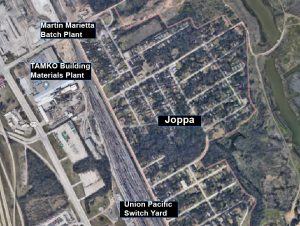 A dense regional Network of air monitors will begin to expose the deep disparities in pollution burdens in Dallas and elsewhere. It’ll provide a map to black and brown neighborhoods they don’t have now, providing further evidence that what you breathe in Dallas depends on where you live in Dallas. There’s plenty of indications this is the real disparity that Dallas City Hall staff are concerned with – even more than higher rates of black childhood asthma.
A dense regional Network of air monitors will begin to expose the deep disparities in pollution burdens in Dallas and elsewhere. It’ll provide a map to black and brown neighborhoods they don’t have now, providing further evidence that what you breathe in Dallas depends on where you live in Dallas. There’s plenty of indications this is the real disparity that Dallas City Hall staff are concerned with – even more than higher rates of black childhood asthma.
The curtains are about to part and provide a much clearer picture of how Dallas’ institutional racism has poisoned its own residents. It behooves everyone who calls themselves an environmentalist in Dallas in 2018 to commit to changing that picture, not just studying it.
GIVING DAY PAYS FOR COMMUNITY ORGANIZING

After almost 30 years of illegally dirty air, Downwinders at Risk still employs the only full time staffer devoted exclusively to DFW air pollution problems.
And they do it with your contributions.
CLICK HERE
TO SECURELY CONTRIBUTE TO DOWNWINDERS
What Your
Giving Day Contribution Pays For:
Community Organizing in Joppa
 From its founding Downwinders has fashioned itself as a grassroots group employing basic community organizing principles.
From its founding Downwinders has fashioned itself as a grassroots group employing basic community organizing principles.
This makes us different than most other green groups, who see themselves advocating for causes. We advocate on behalf of people in neighborhoods and towns who are getting shat on by industry, elected officials, bureaucracies, or all of the above.
The latest example is in Joppa, Dallas oldest Freedman’s township.
Surrounded on three sides by heavy industry and freeways, and on the fourth by a landfill and the Trinity River, Joppa is a small neighborhood that looms large in Dallas history. It’s where “South Dallas” began.
We were invited by Joppa residents to use our new portable PM monitors to sample their air prior to the March City Council vote on two new batch plants. That sampling helped defeat those batch plants.But instead of continuing to play “whack-a-mole” with industrial facilities that keep popping up in Joppa, we  proposed a sustained effort to start undoing the environmental racism that brings them to that community in the first place. We wanted to address the underlying problem, not just the symptoms.
proposed a sustained effort to start undoing the environmental racism that brings them to that community in the first place. We wanted to address the underlying problem, not just the symptoms.
Residents and their supporters hammered out the idea of an“Environmental Preservation District” that would systematically address each of the environmental threats identified by the community, including buffer zones, new pollution controls on local industry, and continuous air monitoring.
And so this coming Monday evening Downwinders will be hosting the first meeting of the “Let Joppa Breathe” Alliance, a new network designed to help press the agenda of the Joppa Freedman’s Township Association citywide and win structural changes.
 This isn’t going to be a short fight. It’ll take years. It’ll take a lot of focused energy. It’ll take a lot of people. But the goal of being able to use a reborn Joppa as a model of how to undo environmental racism in other parts of the City is worth it.
This isn’t going to be a short fight. It’ll take years. It’ll take a lot of focused energy. It’ll take a lot of people. But the goal of being able to use a reborn Joppa as a model of how to undo environmental racism in other parts of the City is worth it.
No other green group in DFW has the resources or the mandate to carry out this kind of long-term community organizing campaign. With you contributions, we’ve been doing them for almost 25 years.
GIVING DAY PAYS FOR INSTITUTIONAL CHANGE
We don’t have an home office
in Austin, or Washington, or NYC.
Our only office is right here in DFW.
We don’t have a national agenda.
We have local agendas that have national impacts.
CLICK HERE
TO SECURELY CONTRIBUTE TO DOWNWINDERS
What Your Giving Day Contribution Pays For
Institutional Change:
Creation of the North Texas Clean Air Network
 currently operate.
currently operate. But we also wanted to make sure it would be a tool for citizen empowerment, so we insisted on having public and public health advocate seats on the board overseeing the new network.
But we also wanted to make sure it would be a tool for citizen empowerment, so we insisted on having public and public health advocate seats on the board overseeing the new network.
Each governing entity joining the network appoints a staff person or elected official. But they also appoint a public representative as well.

 If there’s one critical difference between Downwinders and most other green groups, it’s that we know process is as important as policy. You can improve policy, but the really lasting changes occur when you also change the process itself. When you commit institutional change on behalf of citizens.
If there’s one critical difference between Downwinders and most other green groups, it’s that we know process is as important as policy. You can improve policy, but the really lasting changes occur when you also change the process itself. When you commit institutional change on behalf of citizens. This new independent network will eventually supersede the obsolete system currently run by the state and federal government. It’ll become the default way DFW residents check their air. It’ll bring challenges and changes to environmental enforcement, zoning and land use planning, and even the timing of traffic lights. It gives citizens and local governments a powerful new tool.
GIVING DAY PAYS FOR CITIZEN SCIENCE

Downwinders is a entirely local group,
run by board members who live in DFW,
and funded by local contributions. Like yours.
CLICK HERE
TO SECURELY CONTRIBUTE TO DOWNWINDERS. THANKS
What Your Contribution Pays For:
Citizen Science
In the past 18 months, Downwinders at Risk has become the leading sponsor of environmental Citizen Science projects in DFW. Your Giving Day contribution today will help us pay for the following:
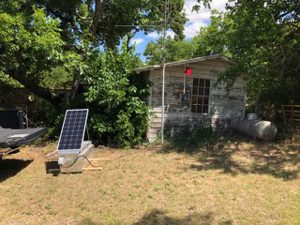 The Wise County Ozone Project
The Wise County Ozone Project
 powered portable ozone monitoring station (ATLAS) so we could deploy them anywhere in Wise County. This July they were installed on site and now a non-profit clean air group is performing the air quality monitoring duties of the state and federal government – all for about $13- $14,000 dollars.
powered portable ozone monitoring station (ATLAS) so we could deploy them anywhere in Wise County. This July they were installed on site and now a non-profit clean air group is performing the air quality monitoring duties of the state and federal government – all for about $13- $14,000 dollars. This is the purest piece of citizen science we’re committed to. We’re not sure what we’ll find. But we’re not afraid to take on a basic job government is supposed to be doing.
This is the purest piece of citizen science we’re committed to. We’re not sure what we’ll find. But we’re not afraid to take on a basic job government is supposed to be doing.Portable Monitors: Training and Lending Library

Shannon Gribble and Cresanda Allen on a monitoring run in Joppa
Earlier this year we bought two portable Particulate Matter (PM) monitors that had just come onto the market from a
New Zealand company, Aeroqual. Calibrated at the factory, these monitors were better than anything else on the market for the price – $1600 each.
Shortly after taking delivery, Joppa residents asked us to bring them to that neighborhood to sample what the air they were breathing was like even before two proposed new batch plants opened there. Our monitors recorded levels of PM pollution much higher than those found at the only official PM monitor in Dallas County hosts, nine miles away – the same monitor city staff was trying to use to say how clean Joppa air was. Our results sealed the defeat the new Joppa batch plants.
With the help of the Dallas Sierra Club and others contributing to the May 22nd Joppa benefit, we were able to buy a third Portable PM Monitor for use exclusively in Joppa, where it now resides 24/7. This December we’ve budgeted to buy two more, giving us a total of five by the end of the year.
Meanwhile, EPA and Areoqual established a national partnership for air quality monitoring, enhancing the credibility of our monitors and our results.
 This Saturday, members of our PM Committee will be hosting free public training sessions on how to use our portable monitors in the field. When you’ve completed three field trips with our team, we’re giving you the chance to ‘”check-out” the portables for your own use or to further help us research local PM levels at specific sites.
This Saturday, members of our PM Committee will be hosting free public training sessions on how to use our portable monitors in the field. When you’ve completed three field trips with our team, we’re giving you the chance to ‘”check-out” the portables for your own use or to further help us research local PM levels at specific sites.
Today is Giving Day…..
New Study Finds PM in Placentas

Scientists already knew that maternal exposure to PM pollution had the potential to harm fetal development. Studies have documented higher rates of Autism, ADHD and other developmental diseases in close proximity of freeways and other large sources of PM pollution. But until now researches hadn’t actually identified how PM harmed newborns.
According to a study presented last week at the European Respiratory Society’s (ERS) international congress in Paris, researchers have found the first evidence that particles of air pollution travel through pregnant women’s lungs and lodge directly in their placentas.
Using an optical microscope, they examined the placentas of five non-smoking women who all delivered healthy babies. They found 72 dark particles among 3,500 cells and then used a powerful electron microscope to examine the shape of some of the particles. They looked like the sooty particles found in macrophages in the lung.
One of the study’s authors, Dr Lisa Miyashita of Queen Mary University of London, ruled out almost any other substance, “We can’t think of anything else they could be. It is very evident to us they are black sooty particles.” Dr Norrice Liu, also at Queen Mary University of London and part of the team stated, “We also know that the particles do not need to get into the baby’s body to have an adverse effect, because if they have an effect on the placenta, this will have a direct impact on the foetus.”
Almost every effort examining the health effects from PM pollution over the last decade have all concluded there’s no level of exposure that’s not capable of leaving some harm behind. What this new study indicates is that many of us may already be harmed by exposure even before we’re born and that may make additional exposure that much more harmful.
Just this past month two new reports were published that linked PM pollution to significant IQ loss and diabetes.
In separate research, also presented at the Paris congress, researchers found that children with early onset and persistent asthma fared far less well in education than those without the condition.
The study, conducted over 20 years in Sweden, showed that children with asthma were three and half times more likely to leave school at the age of 16 with only basic education and were also twice as likely to drop out of university courses
Take 60 Seconds and Urge Dallas City Council Members To Approve Joining A New Regional Air Monitoring Network
CLICK HERE
TO SEND A PREPARED EMAIL TO DALLAS CITY COUNCIL MEMBERS URGING DALLAS JOIN THE NEW NORTH TEXAS CLEAN AIR MONITORING NETWORK
Next Monday, September 24th, the Dallas City Council’s Quality of Life Committee will have a chance to take the City’s air quality tools into the 21st Century.
Committee members will view a presentation on the fledgling North Texas Clean Air Network and be asked to join Plano and Dallas County in signing-on to the state’s first independent air monitoring network. A yes vote will send the decision to the full City Council.
 There’s no mandatory fee to join. Every city, county or other governmental entity gives what it wants. This slow cook approach has already put 50-70 new high-tech-low-cost monitors in play from Plano to Joppa over the past year.
There’s no mandatory fee to join. Every city, county or other governmental entity gives what it wants. This slow cook approach has already put 50-70 new high-tech-low-cost monitors in play from Plano to Joppa over the past year.
Fueled by expertise at area research universities and constructed with the help of local officials and environmentalists, the Clean Air Network treats air quality monitoring as a public health tool to be run as a public utility.
Once in place, dense grids of real time Particulate Matter pollution monitors can have lots of benefits and uses. They can act as 24/7 fence line mon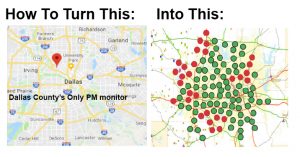 itoring for industrial facilities, help determine the right timing of traffic lights to reduce air pollution, map pollution disparities neighborhood by neighborhood, and correlate pollution burdens with public health. Because of its potential to inform and create policy, this air monitoring network represents one of the most significant environmental advances for DFW this century.
itoring for industrial facilities, help determine the right timing of traffic lights to reduce air pollution, map pollution disparities neighborhood by neighborhood, and correlate pollution burdens with public health. Because of its potential to inform and create policy, this air monitoring network represents one of the most significant environmental advances for DFW this century.


